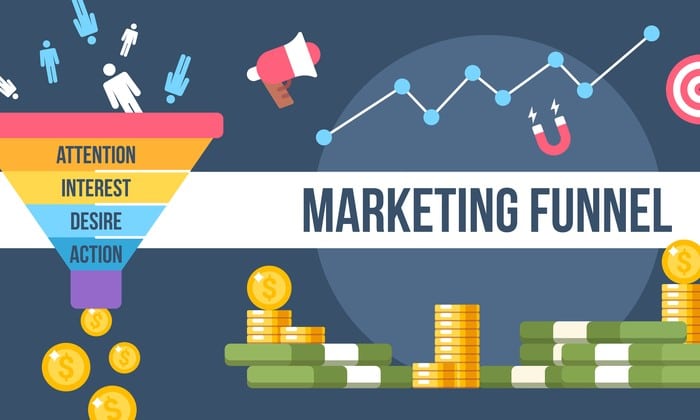How to maximize marketing funnel revenue?
Small businesses have good ideas, well-developed products, and high-quality services. But they don’t gain traction. Why?
Lack of results can be attributed to thousands of company-specific factors and circumstances, but one simple fact often underlines it:
Most businesses don’t have a marketing plan. If they have a plan, it’s not optimized for how people shop and make decisions.
Whether it’s impatience or ineptitude, most companies don’t nurture leads. They prefer fast sales. (Unfortunately, this mindset costs many valuable leads.)
Once you understand how to nurture prospects and convert them into customers, you’ll realize all businesses work the same way.
This article explains marketing funnels, how they work, and how to build a funnel website that leads to sales.
How the Sales Funnel Works: 5 Sales Funnel Steps
Each sales funnel has its unique procedures, but they always follow five fundamental stages. The human psyche is mostly the same. People may look diverse, and in many ways they are, yet consumers respond predictably and again. Thus, breaking the sales funnel into five steps helps standardize the process.
We’ll explore how to target clients at each step with high-converting content next. For now, let’s comprehend what’s going on in each one (from the perspective of the customer).
- Problem/Need Recognition
People realize they have a problem at this stage. It’s the funnel’s peak. (A person isn’t in your funnel until this stage.) You can’t help them since they have no problem.
- Search
While some individuals live with a problem or need for days, weeks, months, or years before acting, most try to fix it as soon as feasible. Then they seek information. This step places the user at the marketing funnel’s top.
In the information search stage, prospects research products and solutions, compare companies, get prices, ask questions, read reviews, etc. At this stage, many would-be marketers focus on vanity metrics instead of conversions. While top-of-funnel metrics can help later success, they are not success in and of themselves.
- Evaluation of alternatives
Evaluation is often the part that takes the most time, especially if there are different options or if the customer can’t decide.
The faster a prospect moves from stage three to stage four, the lower the price point and/or the less important the outcome. For example, it only takes a few minutes to decide between Chick-fil-A and Subway for lunch.
- Deciding to Buy
Three stages lead to the purchase decision. At this point, a customer is ready to pull out her wallet and swipe her card.
- Post-purchase behaviour
The customer wants to know if they made the right purchase. Those who make the right choice will want to tell others. (Also if they regret their purchase.)
State-specific high-converting content
Now that we understand the funnel and how people move from problem awareness to purchase, let’s examine the role of content.
How can you create high-converting content that greases the funnel, addresses prospects at each stage, and pushes them to buy?
- Stage 1 Content (Problem/Need)
In the first stage, you use content to help people realize they have a problem. In this stage, articles, ads, webinars, podcasts, and paid searches lead to landing pages.
Despite the temptation to push your product on a prospect or make a quick sale, this stage is about laying the groundwork. You help them recognize a problem or reassure them that their need is valid.
- Stage 2 Content (Information Search)
In stage two, the prospect wants a solution and is actively seeking information. Content options include websites, social media, blogs, newsletters, and email campaigns.
Guest blog posts help at this stage (as well as the next one). They are neutral and helpful. Webinars can go deep and build trust.
- Stage 3 Content (Evaluation of Alternatives)
Your content should promote your product or service. You can do this by amplifying your brand and using social proof to explain why you’re the best, or by explaining why the competition can’t match up and/or why other options are a mistake. In this phase, white papers, e-books, brochures, and PDF guides are common.
- Stage 4 Content (Purchase Decision)
Buy time! As we discussed in stage four of the marketing funnel, you’re on the one-yard line. Good stage content is safe and encouraging. Be specific. This includes case studies, testimonials, and datasheets. You should remind the prospect why they chose you.
- Stage 5 Content (Post Purchase Behavior)
Stage five is important, especially for subscription-based businesses and other brands that rely on repeat purchases. The goal of this phase is to wow customers, reassure them they made the right choice, and upsell or cross-sell.
If you have a multi-level business model with low activity rates, you should use the record website visitor behavior tool to track your customer behavior and understand why your business is not performing well.

























